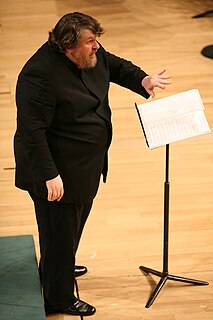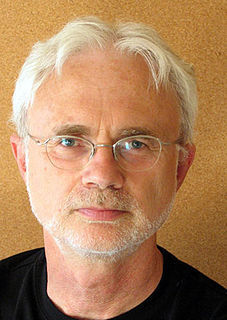Related Research Articles

Dreimal sieben Gedichte aus Albert Girauds "Pierrot lunaire", commonly known simply as Pierrot lunaire, Op. 21, is a melodrama by Arnold Schoenberg. It is a setting of 21 selected poems from Albert Giraud's cycle of the same name as translated into German by Otto Erich Hartleben. The work is written for reciter who delivers the poems in the sprechstimme style accompanied by a small instrumental ensemble. Schoenberg had previously used a combination of spoken text with instrumental accompaniment, called "melodrama", in the summer-wind narrative of the Gurre-Lieder, which was a fashionable musical style popular at the end of the nineteenth century. Though the music is atonal, it does not employ Schoenberg's twelve-tone technique, which he did not use until 1921.

Stuart Oliver Knussen was a British composer and conductor.

The contrabass clarinet and contra-alto clarinet are the two largest members of the clarinet family that are in common usage. Modern contrabass clarinets are pitched in B♭, sounding two octaves lower than the common B♭ soprano clarinet and one octave lower than the B♭ bass clarinet. Some contrabass clarinet models have a range extending down to low (written) E♭, while others can play down to low D or further to low C. This range, C(3) – E(6), sounds B♭(0) – D(4). Some early instruments were pitched in C; Arnold Schoenberg's Fünf Orchesterstücke specifies a contrabass clarinet in A, but there is no evidence of such an instrument ever having existed.

Wallingford Constantine Riegger was an American music composer, well known for orchestral and modern dance music, and film scores. He was born in Albany, Georgia, but lived much of his life in New York City. He is noted for being one of the first American composers to use a form of twelve-tone technique.

The E-flat clarinet is a member of the clarinet family, smaller than the more common B♭ clarinet and pitched a perfect fourth higher. It is typically considered the sopranino or piccolo member of the clarinet family and is a transposing instrument in E♭ with a sounding pitch a minor third higher than written. In Italian it is sometimes referred to as a terzino and is generally listed in B♭-based scores as terzino in Mi♭. The E-flat clarinet has a total length of about 49 cm.

Gurre-Lieder is a large cantata for five vocal soloists, narrator, chorus and large orchestra, composed by Arnold Schoenberg, on poems by the Danish novelist Jens Peter Jacobsen. The title means "songs of Gurre", referring to Gurre Castle in Denmark, scene of the medieval love-tragedy revolving around the Danish national legend of the love of the Danish king Valdemar Atterdag for his mistress Tove, and her subsequent murder by Valdemar's jealous Queen Helvig.

A Pierrot ensemble is a musical ensemble comprising flute, clarinet, violin, cello and piano, frequently augmented by the addition of a singer or percussionist, and/or by the performers doubling on other woodwind/stringed/keyboard instruments. This ensemble is named after 20th-century composer Arnold Schoenberg’s seminal work Pierrot Lunaire, which includes the quintet of instruments above with a narrator.
Chamber Symphony No. 2, Op. 38, by Arnold Schoenberg was begun in 1906 and completed in 1939. The work is scored for 2 flutes, 2 oboes, 2 clarinets, 2 bassoons, 2 horns, 2 trumpets and strings, and is divided into two movements, the first marked Adagio and the second marked Con Fuoco-Lento. The work's belated completion was prompted by the conductor Fritz Stiedry, who asked Schoenberg for an orchestral piece for his New Friends of Music Orchestra in New York. The work was first performed there on December 14, 1940, under Stiedry's direction.
The Symphony No. 1 Elevamini is an orchestral work by Australian-born composer Malcolm Williamson.

The Chamber Symphony No. 1 in E major, Op. 9 is a composition by Austrian composer Arnold Schoenberg.
Adam Schoenberg is an American composer. A member of the Atlanta School of Composers, his works have been performed by numerous orchestras and ensembles in the U.S. Schoenberg was the 2010-2012 guest composer for the Aspen Music Festival, the 2012-2013 composer-in-residence for the Kansas City Symphony, the 2013-2014 composer-in-residence for the Lexington Philharmonic, and the 2015-2017 composer-in-residence for the Fort Worth Symphony. Schoenberg's honors include a 2009 and 2010 MacDowell Colony fellowship, the 2007 Morton Gould Young Composer Award from ASCAP, and the 2006 Charles Ives Prize from the American Academy of Arts & Letters.

Chamber Symphony is a 1992 composition for a 15-member chamber orchestra by American composer John Adams, inspired by Arnold Schoenberg's Chamber Symphony No. 1, Op. 9. It is a three-movement work that takes about 23 minutes to perform.
The B-Sides is a symphony in five movements for electronica and orchestra by the American composer Mason Bates. The work was commissioned by the San Francisco Symphony and conductor Michael Tilson Thomas, with support from the Ralph I. Dorfman Commissioning Fund. It was premiered May 20, 2009 at the Louise M. Davies Symphony Hall in San Francisco, with Michael Tilson Thomas leading the San Francisco Symphony.
The Little(Chamber) Symphony No.5, Op.75, also known as the Tentet, is a symphony for wind instruments written by French composer Darius Milhaud in 1922. It is his fifth chamber symphony, which are also referred to as the Petites Symphonies or Chamber Symphonies. The work was commissioned by Italian Radio and is dedicated to Marya Freúnd, a soprano singer and Milhaud's friend, who performed the premiere of Schoenberg's Pierrot Lunaire, conducted by Milhaud. The symphony was first performed at Champs-Elysées, Paris in 1923.
Helly Nahmad is an American art dealer and art collector. In 2000 he founded the Helly Nahmad Gallery in Manhattan, New York, which holds several fine art exhibitions each year featuring artists such as Pablo Picasso, Chaim Soutine, Francis Bacon, and Giorgio de Chirico.
Popol Vuh: The Creation of the Mayan World, Op. 44, is a symphonic poem in seven movements by the Argentine composer Alberto Ginastera. The work, which remains unfinished, was composed between 1975 and 1983. It was first performed by the St. Louis Symphony under the direction of Leonard Slatkin at Powell Hall in St. Louis on April 7, 1989.
The American Symphony is a symphony for orchestra by the American composer Adam Schoenberg. The work was commissioned by the Kansas City Symphony and was completed in early 2011. It was first performed by the Kansas City Symphony under the direction of Michael Stern at the Kauffman Center for the Performing Arts in Kansas City on March 4, 2011.
Finding Rothko is a composition for chamber orchestra by the American composer Adam Schoenberg. The work was commissioned by the Germantown, Tennessee-based IRIS Orchestra under the conductor Michael Stern. It was first performed by the IRIS Orchestra under Stern on January 13, 2007.
The Symphony No. 6, From a New Zealand Diary, Op. 65, is an orchestral composition by the Finnish composer Aulis Sallinen, who wrote the piece from 1989–90. The New Zealand Symphony Orchestra, the commissioning institution, premiered the work on 6 September 1990 in Napier, under the baton of Sallinen's longtime advocate, Okko Kamu. Sallinen and his wife had vacationed in New Zealand the year prior, providing the composer with inspiration for the symphony, which—though properly symphonic in scope and in structure—has been described as involving "tone painting"; indeed, each of the four movements contains a descriptive title, unusual for a Sallinen symphony.
References
- 1 2 Schoenberg, Adam (2012). Program Notes: Picture Studies. Retrieved August 28, 2017.
- ↑ McDonald, Timothy L. (February 3, 2013). "Review: Cellist, KC Symphony give thrilling performance of Schumann concerto". The Kansas City Star . Retrieved August 28, 2017.
- ↑ Neas, Patrick (June 7, 2014). "Kansas City Symphony prepares to record Adam Schoenberg's work". The Kansas City Star. Retrieved August 28, 2017.
- ↑ Neas, Patrick (July 1, 2017). "Four new classical CDs, including one by KC Symphony, worth a listen". The Kansas City Star. Retrieved August 28, 2017.
- ↑ Castillo, Patrick (February 27, 2017). "Rothko and Americana Inspire Orchestral Works of Adam Schoenberg". WQXR-FM . Retrieved August 28, 2017.